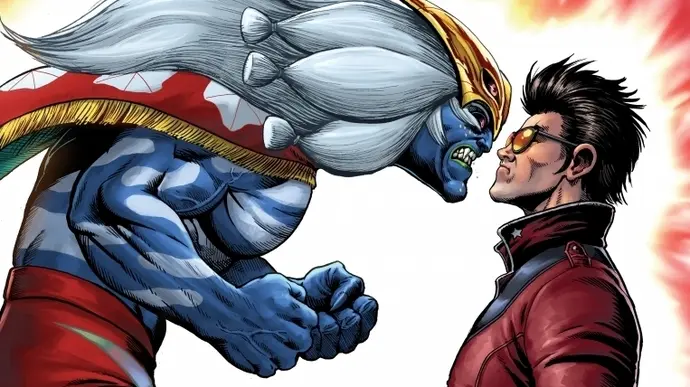
Series hero Travis Touchdown makes an appearance on a TV program during one of the many, many, many fourth-wall breaching moments in No More Heroes 3 to talk about his admiration and enthusiasm for the work of Takashi Miike, one of the most prolific, diverse, and downright insane filmmakers in Japanese movie history. In a series full of them, this is just another self-serving pop culture allusion, but this one is unique in that it seems like Goichi Suda, the show’s creator, is at least somewhat in line with Miike.
This is highlighted when Travis launches into a long-winded tirade about how, in an attempt to bolster his production team, a filmmaker such as Miike—whose most infamous film opens with a splash of semen—went on to develop the idol series Girl x Heroines. It’s something that Suda himself accomplished with Travis Strikes Again, the simple spin-off he used to mentor his young crew prior to them starting development on the main No More Heroes game.
I hated that specific game for adhering too closely to the series’ excesses while eschewing most of its aesthetic, but now I am completely enamored with No More Heroes 3. What has changed, then? That this is a true No More Heroes game, with Travis slicing through tiny groups of enemies and taking on large monsters with his scythe, helps. With the open world elements that were removed for No More Heroes 2 reinstated, along with some style, it’s even more of a No More Heroes game than the 2010 sequel.
Although the setup is well-known, Suda deserves credit for making it seem even more ridiculous than previous attempts. A child becomes friends with Fu, a fluffy extraterrestrial, in this adorable cartoon parody of Spielberg’s schmaltz from the 1980s, and they assist him in returning to his home planet with the hope that he may one day make a return. He returns after around twenty years, but this time he’s transformed into a flamboyant, opulent, and, I must admit, brilliantly made alien who is hellbent on chaos. He’s also brought along a group of extraterrestrials from the jail he’s just had a stint at.
Thus starts Travis’s mission to eliminate each of them individually until he is recognized as the top assassin. Everything is the same as it was back then, but the action is also a little bit more intense since the stakes are bigger this time. I kind of forgot how much I loved No More Heroes’ unique style of action after the incredibly streamlined Travis Strikes Again. It was straightforward but satisfying and delivered with screen-filling exuberance, with the signature beam katana contributing to jaw-dropping Death Blows and the combat feeling strengthened by a few clever additions.

It’s true that one of them is directly lifted from Travis Strikes Again—perhaps I was too harsh on it after all—with a Death Glove that can be set to three different skills, adding a welcome variety. However, more significantly, Travis can now go “Full Armor,” donning a mech suit that ups the ante to an enjoyable level and, of course, comes with a “Henshin” battle cry.
One of the many minigames in the reopened open world is the shooting defense missions, where that mech suit makes an appearance. As apprehensive players of the first game may be relieved to hear, No More Heroes 3 is a rather dreary open world – partially as a kind of parody, and partially because of the lingering impression that it was produced on a shoestring on some backlot by a group of people high on cheap beer and even cheaper hash.


Which, despite its potential for division, is undoubtedly part of the series’ appeal. With its barren backlots and deserted streets, the bleached-out Santa Destroy somehow manages to evoke the baked banality of Philip K. Dick’s California. No More Heroes 3’s world, which is cleverly divided into five sections and can be explored with ease on Travis’s ostentatious big red bike, keeps all of that while outperforming its infamously leaden predecessor. Which is not to suggest that it’s attractive—far from it—but this time around, it works.
The gonzo stylings of Grasshopper Manufacture and Suda himself, on the other hand, are what I believe draw players to a No More Heroes game, and No More Heroes 3 delivers on that promise in a gleeful manner. With a longer playtime than its predecessors, there’s a good possibility that this will try the patience of even ardent fans. Whether it irritates or titilates is mostly a matter of personal taste, or maybe even mood.
Still, I kind of liked it. Does it make any significant changes to the No More Heroes formula? Not much, and the little additions and adjustments don’t quite equal a decade’s worth of advancement. Does it have all the vigor and bravado of those classic games, or does it misfire more often than not? Yes, it does, abundantly. This is a return to more intense, chaotic, and wildly extravagant action; it’s a loud, creative, and wildly uneven game. Still, consider it one of Suda’s greatest creations and maybe the best No More Heroes game to date.